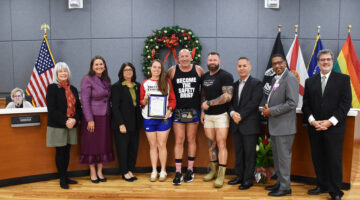A Look at Florida 60 Days after Hurricane Irma
ORLANDO, Fla. – Florida continues making efforts toward recovery from Hurricane Irma’s severe impact on the entire state – spanning 65,755 square miles from Pensacola on the west end of the Panhandle, Jacksonville on the east coast, south to Key West.
Affected communities and disaster survivors are repairing and rebuilding better, stronger and safer with the help of neighbors, friends, family members, voluntary groups, faith- and community-based organizations and local, county, state and federal governments.
Recovery takes the whole community. The following are highlights of the progress made within the first 60 days since the September 10 presidential disaster declaration and how disaster survivors and affected communities are overcoming challenges:
Assistance to Floridians and the Communities They Live In
Survivors in 48 of the 67 Florida counties are eligible to apply for help under FEMA’s Individual Assistance (IA) program. All 67 counties in the state are eligible to receive federal funding through FEMA’s Public Assistance (PA) program for debris removal and emergency protective measures, including direct federal assistance.
In addition, local, county and state government infrastructure and certain private nonprofit organizations in 55 Florida counties became eligible to receive all categories of PA funding including the repair and rebuilding of certain eligible disaster-damaged facilities.
The PA program benefits everyone in the affected communities because essential services such as roads, utilities, schools and hospitals are restored. FEMA relieves burdens of local and county governments and the state by paying 75 percent of the eligible costs.
Additionally:
So far, more than 2.6 million Florida households have contacted FEMA for IA help. The deadline for survivors to register for federal aid under the IA program is Friday, Nov. 24, 2017.
-
To date, Floridians have received more than $1.5 billion through funding from FEMA, the U.S. Small Business Administration and the National Flood Insurance Program.
-
Of that total, more than $899 million in FEMA individual assistance has gone to homeowners and renters whose insurance, or other forms of disaster assistance received, could not meet their disaster-caused needs.
-
Homeowners, renters and businesses have received $388 million in 10,579 low-interest disaster loans from the U.S. Small Business Administration (SBA) to repair, rebuild and replace damaged property and contents. SBA offers low-interest disaster loans to businesses of all sizes, private nonprofit organizations, homeowners and renters. The deadline to apply is Nov. 24, 2017.
-
NFIP policyholders have received more than $239.5 million in more than 26,600 claims to repair and rebuild flood-damaged property.
-
More than 76,700 survivors have visited Disaster Recovery Centers (DRCs). The first centers opened six days after the presidential disaster declaration.
-
More than 797,000 FEMA housing inspections have been completed.
-
FEMA disaster survivor assistance specialists canvassed the affected communities, visiting more than 208,000 homes to encourage survivors to register for help, while providing them with recovery information and listening to their concerns.
Partners in Florida Recovery Efforts
Thousands of disaster recovery officials and volunteers continue to reach out to and interact with survivors and communities in various ways to help them recover. To meet the immediate needs of survivors – including helping to muck and gut homes and provide emotional and spiritual care – more than 300 voluntary agencies logged more than 520,000 volunteer hours.
-
In an effort to help reduce further damage to property until permanent repairs can be made, 13,370 temporary roofs have been installed in Florida by the U.S. Army Corps of Engineers through Operation Blue Roof. The temporary covering of blue plastic sheeting is installed using strips of wood that are secured to the roof with nails or screws.
-
Thanks to a unified effort to mitigate pollution threats from vessels displaced by Hurricane Irma, 1,492 sunken vessels have been recovered/removed from Florida waterways by the U.S. Coast Guard, the Environmental Protection Agency, the Florida Fish and Wildlife Conservation Commission as well as private owners.
-
Through the State of Florida, Floridians have received an estimated $1 million in disaster unemployment assistance if they lost work or are out of work due to Hurricane Irma. This dollar amount continues to increase to assist eligible applicants.
-
The State of Florida reopened approximately 100 roads impacted by the storm across Florida within two weeks after landfall. In addition, local power crews and crews brought in from across the U.S. and Canada restored 99.9 percent of power to 12 million customers in Florida within two weeks after the storm.
The whole community of partners—including other federal agencies, state and local governments, the private sector and voluntary and faith-based organizations—continue to offer a wide range of help for survivors. For more recovery information, visit www.FEMA.gov/IrmaFL, or follow us @FEMARegion4 on Twitter and on FEMA’s Facebook page.
[livemarket market_name="KONK Life LiveMarket" limit=3 category=“” show_signup=0 show_more=0] 

No Comment